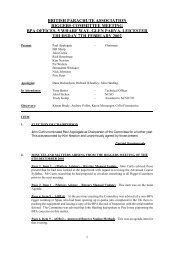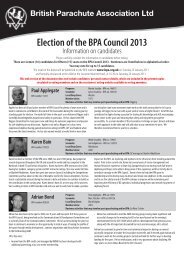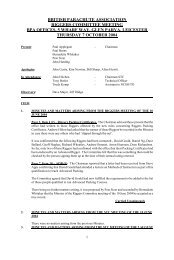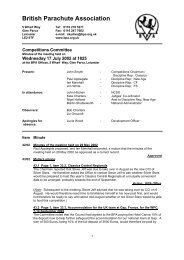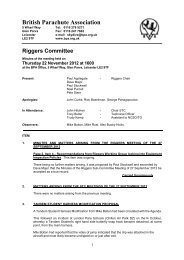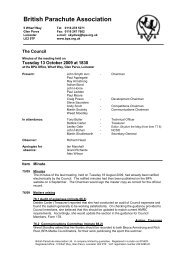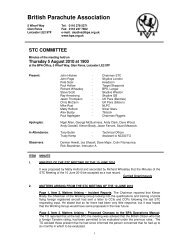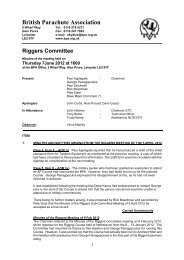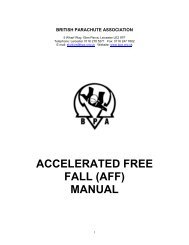7 Feb - British Parachute Association
7 Feb - British Parachute Association
7 Feb - British Parachute Association
You also want an ePaper? Increase the reach of your titles
YUMPU automatically turns print PDFs into web optimized ePapers that Google loves.
<strong>British</strong> <strong>Parachute</strong> <strong>Association</strong><br />
5 Wharf Way Tel: 0116 278 5271<br />
Glen Parva Fax: 0116 247 7662<br />
Leicester LE2 9TF e-mail: skydive@bpa.org.uk<br />
www.bpa.org.uk<br />
Safety & Training Committee<br />
Minutes of the meeting held on<br />
Thursday 7 <strong>Feb</strong>ruary 2013 at 1900<br />
at the BPA Office, 5 Wharf Way, Glen Parva, Leicester LE2 9TF<br />
Present: John Hitchen - Chair STC<br />
Phil Collett - 22 Tng Gp RAF<br />
Paul Floyd - LSC<br />
Pete Sizer - Skydive Headcorn<br />
Noel Purcell - Target Skysports<br />
Stuart Meacock - Hinton Skydiving<br />
Mike Bolton - LPS<br />
Paul Yeoman - Black Knights<br />
Dave Wood - Cornish PC<br />
Chris McCann - UK Parachuting (Sibson)<br />
Brucie Johnson - Skydive London<br />
Ian Rosenvinge - Peterlee<br />
Jay Webster - JSPC(N)/APA<br />
Gary Stevens - Skydive UK Ltd<br />
Alex Busby-Hicks - Tilstock<br />
Jeff Montgomery - Silver Stars<br />
Richard Wheatley - BPS, Langar<br />
Mike Rust - NLSC<br />
Kieran Brady - Skydive Strathallan<br />
Paul Applegate - Chair Riggers Committee<br />
Apologies:<br />
Dennis Buchanan, Bryn Chaffe, Andy Clark, Mal Richardson,<br />
George McGuinness.<br />
In Attendance: Tony Butler - Technical Officer<br />
John Page - Vice Chair STC/Council<br />
Trudy Kemp - Assistant to NCSO/TO<br />
Observers:<br />
Martin Harris, Paul Stockwell, Jay Hart, John Reid, Dave Major,<br />
Anthony Fernyhough, Mark Bayada.<br />
ITEM<br />
MINUTE<br />
1. MINUTES OF THE STC MEETING OF THE 22 NOVEMBER 2012<br />
It was proposed by Mike Rust and seconded by Alex Busby-Hicks that the Minutes of the STC<br />
Meeting of the 22 November 2012 be accepted as a true record.<br />
Carried Unanimously<br />
2. MATTERS ARISING FROM THE STC MEETING OF THE 22 NOVEMBER 2012<br />
Page 3, Item 5, Incident Reports – resume. The Chair reported that the Panel of Inquiry<br />
investigating the incident involving a student who jumped the incorrect equipment was a main<br />
agenda item.<br />
1
Page 4, Item 5, Incident Reports – resume. The Chair reported that the incident where a<br />
hook came undone from a Tandem Student harness had been deferred until this meeting<br />
because it could not be established at the time the identity of the harness. He stated that this<br />
was now known and the video of the jump had been received, though it was not possible to<br />
tell from viewing the video footage exactly when the butterfly snap hook became detached<br />
from the main harness. The harness concerned was available for inspection at the meeting.<br />
As a result of this incident Mike Bolton had proposed that all Tandem Student harnesses be<br />
equipped with securing pins as a mandatory requirement to prevent possibly a repeat incident<br />
occurring in future. This proposal had also been deferred until this meeting.<br />
Some discussion ensued. Most CCIs present felt that Mike’s proposal should not be a<br />
mandatory requirement, but should be a decision for individual CCIs. They felt that if Tandem<br />
Instructors carried out all the necessary checks prior to exit they saw no reason why anyone<br />
should find themselves in freefall with a hook undone.<br />
Although the <strong>Association</strong> did have an accepted modification for locking pins, some concern<br />
had been expressed by the Riggers Committee with regard to drilling of holes into equipment<br />
and the implications involved. They see this as more of an engineering task that needs to be<br />
carried our properly and supervised by an Advanced Rigger.<br />
Following further discussion, Mike Bolton’s proposal failed to find a seconder.<br />
The Chair wished to remind all Tandem Instructors of their responsibility of conducting the<br />
final checks of their equipment prior to exit, as per requirements accepted previously by STC.<br />
Paul Applegate reported that Paratec have stated that they have no objection against the use<br />
of the BPA accepted modification for locking pins on their equipment as an optional feature.<br />
Page 5, Item 6, Proposed change to BPA Operations Manual. The Chair stated that STC<br />
had decided that a Working Group be formed to look at the type of instructor that may be left<br />
in charge of the parachuting operation when the CCI was not present, and also to look at the<br />
various qualifications to attend instructor courses. The Chair reported that this WG had not yet<br />
been formed, but would be in the near future.<br />
Page 6, Item 9, Proposed New DZ/PLA. It was pointed out that the diameter of the DZ<br />
quoted in the 4 th para should read 3 nautical miles and not 3km as stated.<br />
3. RIGGERS’ SUB-COMMITTEE MEETING OF THE 22 NOVEMBER 2012<br />
Paul Applegate stated that he had nothing to report from the previous Riggers Meeting.<br />
There being no matters arising, it was proposed by Paul Applegate and seconded by Pete<br />
Sizer that the Minutes of the Riggers’ Sub-Committee meeting of the 22 November 2012 be<br />
accepted.<br />
Carried Unanimously<br />
Paul Applegate reported on the meeting held that afternoon and stated that the Committee<br />
had discussed the Safety Bulletin issued by Airtec regarding Cypres 2 units manufactured<br />
<strong>Feb</strong>ruary 2009 through December 2012. To perform a mandatory system check before each<br />
jump.<br />
Paul Applegate reported that the Riggers Committee had agreed to adhere to the actions set<br />
out in Airtec’s Bulletin. He stated that there had been some concerns expressed that the<br />
action to be taken in this bulletin may not be acceptable, as having to carry out a pre-boarding<br />
check did not give a great deal of confidence that the unit may be effective after that check. It<br />
was also felt that the situation may be unmanageable as who was going to be responsible for<br />
flight line checking on some units while others are OK. This situation could persist for up to 4<br />
years.<br />
2
However, the Riggers Chair and TO had both spoken at great length to Helmut Cloth of Airtec<br />
on this matter and he had assured them that the actions in their Safety Bulletin were the best<br />
way forward and he was also able to answer any questions put to him.<br />
It had been suggested that all jumpers should perhaps get into the habit of checking all<br />
Cypres units on the flight line, as part of their standard/normal safety checks. CCIs were<br />
urged to instigate a system at their Clubs for ensuring that these checks are carried out.<br />
4. PILOTS’ SUB-COMMITTEE MEETING OF THE 26 JANUARY 2013<br />
Kieran Brady reported that this meeting had been quite lengthy due to the time spent<br />
discussing the Pilots Age Working Group (PAWG).<br />
Kieran stated that during this discussion, a pilot had called for a vote of no confidence in<br />
Kieran as Chair of Pilot’s Sub-Committee, as the pilot believed Kieran had not served the best<br />
interest of pilots in relation to the PAWG. Kieran stated that he was supported by only three<br />
other pilots of the twenty present. Jane Buckle-Hopkins had stated at the Pilots’ meeting that<br />
she believed that the majority present had full confidence in the Chair.<br />
Kieran stated that the person making this proposal was not even a full member of the BPA<br />
and he found this to be personally insulting.<br />
Kieran stated that he had been personally upset and disappointed, as the work that he had<br />
carried out was on behalf of STC. He had been asked to Chair the PAWG and he went away<br />
in all good faith with the other members, and he felt he had done the best he could. He stated<br />
that he did not get involved in any of the arguments and electronic communications regarding<br />
the PAWG and he had tried to remain neutral and impartial throughout.<br />
Kieran voiced his concern at Ian Rosenvinge’s Resolution 2 at the AGM in that he believed it<br />
was personally directed at him.<br />
It was proposed by Kieran Brady and seconded by Stuart Meacock that the Minutes of the<br />
Pilot’s Sub-Committee meeting of the 26 January 2013 be accepted.<br />
Carried Unanimously<br />
5. FATALITY - SIBSON<br />
The Chair reported that at the last STC meeting the Committee had been informed that the<br />
Board of Inquiry Report Resume was being put back until this meeting because the Panel of<br />
Inquiry which was formed after the Board of Inquiry had found other evidence to suggest that<br />
the Board’s conclusions may not be correct. The Board therefore asked the Panel to continue<br />
with their investigations. The amended Board Report Resume had been circulated with the<br />
agenda for this meeting.<br />
At approximately 15.10 hours on Saturday 22 September 2012, Patrick David Sandeman<br />
boarded a Cessna 208B aircraft along with sixteen other parachutists: This was the thirteenth<br />
parachuting lift of the day and the eighth from that aircraft.<br />
The aircraft climbed to approximately 15,000ft AGL. A ‘jump run’ was made over the PLA.<br />
Once the aircraft was at the exit point, the parachutists exited in groups. The first group to exit<br />
were a group of nine, including Matthieu Le Berre, the other parachutist involved in the<br />
accident, who was intending to carry out an FF type of jump, which involved eight parachutists<br />
flying around Matthieu who was holding a ‘tube’. The next group to exit was a 4-way group,<br />
including Patrick, who were also carrying out an FF type jump, with three of them flying<br />
around another ‘tube’, Patrick being one of the flyers. The remaining two 2-way FF groups<br />
exited shortly after.<br />
Patrick was 53 years of age. He had completed 678 jumps prior to the accident and was<br />
jumping a Sabre 150 canopy. Matthieu is 28 years of age. He had completed 459 jumps prior<br />
to the accident and was jumping a Katana 150 canopy.<br />
3
The free fall portion of the jumps for all groups appeared to go without incident. All<br />
parachutists’ canopies were seen to deploy at the correct altitude (between 2-4,000ft AGL),<br />
and all were observed to be flying correctly.<br />
Towards the lower portion of the parachute descent, the deceased’s parachute and the<br />
parachute of Matthieu Le Berre were observed to collide and become entangled, partially<br />
collapsing both parachutes. This occurred at approximately 40-50ft AGL near the intended<br />
landing area. Both parachutists were then observed to impact heavily with the ground.<br />
A BPA Board of Inquiry was immediately instigated. The members of the Board were; John<br />
Hitchen – National Coach & Safety Officer, Tony Butler – Technical Officer and John Page -<br />
BPA Instructor Examiner.<br />
Following their investigations the Board came to the following Conclusions:<br />
‘That: (i) Patrick made an uneventful free fall descent; (ii) he and all the other parachutists<br />
deployed their parachutes at an appropriate height; (iii) the majority of Patrick’s parachute<br />
descent went without incident, until he had ‘set up’ ready for landing.<br />
Matthieu also started to prepare for landing, having made a 90 degree riser turn behind and<br />
higher than Patrick. However, Matthieu’s parachute being a higher performance parachute<br />
and traveling at high speed, caught up with Patrick’s parachute, at which point the parachutes<br />
collided. One or both of the parachutists may have attempted to steer away. However, it is<br />
believed, Patrick’s pilot chute and bridle line caught around the rigging lines and/or pilot chute<br />
and bridle line of Matthieu’s parachute, causing both parachutes to become entangled,<br />
resulting in them partially collapsing. Both parachutists then impacted with the ground at high<br />
speed’.<br />
The Board also made the following Recommendations:<br />
‘That parachutists should be reminded of the importance of ‘all round observation’ throughout<br />
the entire parachute descent and that they check carefully for other parachutists before<br />
turning or carrying out any manoeuvres’.<br />
However, since the Board of Inquiry was finalised on the 8 October 2012, additional evidence<br />
had come to light as part of the Panel of Inquiry’s investigations into the peripheral aspects of<br />
the fatality. In light of the evidence and as part of their deliberations, the Panel was asked to<br />
review the Board of Inquiry’s Conclusions. The Panel of Inquiry consisted of Gary Small –<br />
Instructor Examiner (Chairman), Jay Webster – Advanced Instructor, Club Chief Instructor<br />
and Malcolm Richardson - Advanced Instructor, Club Chief Instructor.<br />
The Panel’s Conclusions were as follows:<br />
‘The Panel agrees with the majority of the Board of Inquiry report. The only differences are<br />
that the Panel believes that it was more likely that Patrick Sandeman collided with Matthieu Le<br />
Berre, though the evidence is not conclusive either way. The Panel’s conclusions are as<br />
follows:<br />
The incident between Patrick Sandemann and Matthieu Le Berre occurred during normal<br />
parachuting operations at UK Parachuting Sibson. The lift on which the incident occurred was<br />
the 13 th lift of the day but only the 8 th lift from the Cessna Caravan (N208AJ). The freefall part<br />
of the descents went according to plan with all groups separating and deploying their<br />
parachutes between 2000ft and 4000ft.<br />
Matthieu Le Berre should have deployed his main parachute at 5000 ft due to the fact he was<br />
flying a tube. However, he deployed parachute at approximately 4000ft.<br />
The majority of the canopy descents went according to plan. It is the Panel’s opinion that it is<br />
most likely that Patrick Sandemann instigated a radical turn at a low altitude, possibly a spiral<br />
turn and flew into the rear of Matthieu Le Berre’s canopy. This would have been a major<br />
contributory factor leading to this incident. Both canopies touched, briefly separated and then<br />
entangled. Both canopies collapsed resulting in both parachutists impacting the ground at<br />
high speed’.<br />
The Panel came to the above Conclusions after interviewing additional witnesses and<br />
4
studying additional video footage.<br />
Members of the BPA Board of Inquiry were grateful to the Panel of Inquiry for bringing the<br />
additional evidence to their attention and the conclusions of the Panel were fully endorsed by<br />
the Board members.<br />
The Recommendations of the Board remain as stated above.<br />
It was proposed by Jason Webster and seconded by Mike Rust that the Board of Inquiry<br />
Report, including the recommendations and conclusion be accepted.<br />
Carried Unanimously<br />
The Chair reported that the Panel of Inquiry Report was a main agenda item and he<br />
expressed his thanks to the Panel for their work in this matter.<br />
6. FATALITY - STRATHALLAN<br />
The Chair reported that unfortunately, there had been a fatal accident at Skydive Strathallan<br />
on the 5 January 2013. The Board of Inquiry Report resume had been circulated to CCIs with<br />
the agenda. A copy of the resume was also tabled to those present.<br />
At approximately 12:30 hours on Saturday 5 January 2013 at Skydive Strathallan, David Ball<br />
boarded a Cessna 206 aircraft along with two other parachutists. This was to be the sixth<br />
parachuting lift of the day. The aircraft climbed to approximately 2,400ft AGL. A ‘jump run’<br />
was made over the centre of the PLA. Once the aircraft was at the correct exit point the<br />
parachutists exited individually, leaving at intervals of approximately three to five seconds<br />
between each parachutist. David was the last parachutist to exit the aircraft.<br />
David was carrying out a short freefall delay jump in order to have his parachute open by<br />
2,000ft AGL. His parachute was seen to have fully deployed but was observed to be turning to<br />
the left. His parachute continued to turn, gradually increasing in speed during the decent and<br />
he was observed attempting to kick out of twists. At approximately 400ft AGL the David’s<br />
main parachute was seen to cutaway and he was observed to fall away until he was lost from<br />
view behind some tall trees. No reserve parachute deployment was observed.<br />
A BPA Board of Inquiry was immediately instigated. The members of the Board were; Tony<br />
Butler – Technical Officer and Rob Noble-Nesbitt - BPA Instructor Examiner.<br />
David was 56 years of age. He was a ‘B’ Licenced parachutist with 123 descents prior to the<br />
accident. He had been parachuting since September 2011. He was trained at in Portugal,<br />
where he made his first 50 jumps. The majority of his jumps since then had also made in<br />
Portugal. He had completed a total of 22 jumps in the UK, of which 18 were made at Skydive<br />
Strathallan.<br />
When examining the equipment it was noted that the steering toggles of the main parachute<br />
were still fully stowed in their keepers. The main parachute cutaway pad was not with the<br />
equipment and was not found. The reserve parachute pilot chute, the bridle-line and the<br />
reserve parachute deployment bag were outside of the container, but none of the rigging lines<br />
or reserve parachute had deployed. It was also noted that the AAD had not activated and that<br />
the reserve container closure loop had not been cut, but had broken below the loop, most<br />
probably on impact. The equipment was not fitted with a RSL.<br />
The conclusions of the Board are that David was used to jumping from higher altitudes and<br />
had made very few of his jumps from lower altitudes. He had experienced twists in the<br />
canopy’s rigging lines on previous occasions and presumably had had the time and height to<br />
kick out of the twists without further problem. However, on this occasion he opened his<br />
parachute at a lower altitude than he was used to (approximately 1,900ft AGL). He was<br />
jumping a high performance canopy and it is known that it can be extremely difficult (in some<br />
instances impossible) to clear twists when jumping a canopy of this type.<br />
The Board believe that he continued to attempt to kick out of the twists past the point at which<br />
he should have initiated his emergency procedures. The Board also believe that it is unlikely<br />
that he realised how low he was when he decided that he was unable to clear the twists and<br />
5
take control of the parachute. This resulted in him initiating his emergency procedures at the<br />
extremely low altitude of approximately 400ft AGL.<br />
He then cutaway his main canopy and probably attempted to pull his reserve ripcord handle.<br />
He may not have fully had hold of the handle, as it was later found to be partially dislodged<br />
from its pouch. He may have, instead, pulled on the ripcord cable enough to open the reserve<br />
container just before impact. In addition, he was jumping a full-faced helmet which may have<br />
partially obscured his vision. However, it is also possible that he may not have opened the<br />
container and that it opened on impact.<br />
From 400ft, if David had pulled (or been able to pull) his reserve ripcord immediately after he<br />
had cutaway, or if an RSL had been fitted, there is a possibility that the reserve parachute<br />
may have been able to deploy prior to impact.<br />
The Recommendations of the Board were as follows:<br />
a) That parachutists should be reminded of the importance of carrying out their reserve<br />
procedures as soon as possible and that they must not wait to carry them out at too<br />
low an altitude.<br />
a) That Licensed parachutists should consider the benefits of using equipment fitted with<br />
RSLs.<br />
It was proposed by Paul Floyd and seconded by Richard Wheatley that the Board of Inquiry<br />
Report, including the recommendations and conclusion be accepted.<br />
Carried Unanimously<br />
The Chair reported that it was Council Policy that a Panel of Inquiry is formed following a<br />
Board of Inquiry to investigate any peripheral aspects of the fatality.<br />
He stated that a Panel had been formed and comprised the following members: Mark Tether<br />
(Chair), Jane Hopkins and Brucie Johnson. There were a number of aspects the Board<br />
wished to be considered, that had been highlighted because of their investigations, which<br />
included the following:<br />
a. Should certain licensed parachutist’s minimum opening height be increased. Most<br />
jumpers these days open above 2,000ft AGL. The 2,000ft rule came into force when<br />
most parachutists were jumping round and then docile ram-air canopies. These days<br />
with high performance canopies, if parachutists encounter a problem, altitude is likely<br />
to be lost very quickly. Possibly worth considering, for example, having a minimum<br />
altitude of 2,500ft for parachutists between A & C licence.<br />
b. Parachutists are taught when initially trained that twists are a nuisance factor and not<br />
a malfunction. Should there be some kind of formal briefing/training when parachutists<br />
move to a higher performance canopy, that includes information that encountering<br />
twists on opening may quickly turn into a malfunction type of situation.<br />
c. AADs are required for all parachutists up to B Licence, yet RSLs are only required up<br />
to A Licence. Should RSLs be required up to at least B Licence also?<br />
d. Full-faced helmets can restrict vision, which could affect the location of emergency<br />
pads/handles, yet a parachutist with a B Licence could jump one, if their CCI permits<br />
it. Should there be further restrictions.<br />
The TO stated that he believed that all parachutists should be reminded that when practicing<br />
their emergency drills, to make them as realistic as possible, i.e. put on their jumpsuits,<br />
gloves, goggles, helmets (especially if they jump a full-faced helmet).<br />
The Chair stated that any CCI who wished the Panel to consider any other areas to please<br />
contact the Panel Chair.<br />
7. INCIDENT REPORTS – RESUME<br />
6
The Chair reported that there had not been a great deal of parachuting taking place since the<br />
last STC meeting and the number of reports received reflected this.<br />
i) There had been 2 Student Injury Reports received since the last STC meeting. Both<br />
male.<br />
ii)<br />
iii)<br />
iv)<br />
Since the last meeting there had been 1 Injury Report received for an ‘A’ Licence<br />
parachutist or above. A male.<br />
There had been 6 Student Malfunction/Deployment Problem Reports received since<br />
the last meeting. 5 male and 1 female.<br />
There had also been 17 Malfunction/Deployment Problem Reports received for ‘A’<br />
Licence parachutists or above. All male.<br />
v) Since the last STC there had been 2 Tandem Injury reports received. Both male.<br />
vi)<br />
vii)<br />
viii)<br />
ix)<br />
There had also been 3 Tandem Malfunction/Deployment Problem reports received.<br />
There had been 1 report received of an AAD fire. An aircraft had to descend with a<br />
Student on board. The aircraft descended too quickly and the Student’s Cypres fired.<br />
A report had been received of a helmet coming off in freefall.<br />
Seven reports had been received of ‘off landings’. All at Clubs.<br />
x) A report was received of a jumper with 26 jumps caught with camera on his wrist on<br />
the flight-line.<br />
8. PANELS OF INQUIRY<br />
The Chair reported that as he had previously stated it was Council Policy that a Panel of<br />
Inquiry is formed following a Board of Inquiry to investigate any peripheral aspects to the<br />
accident. He stated that three Panel of Inquiry reports had been circulated with the agenda.<br />
Two following fatalities.<br />
a. Black Knights <strong>Parachute</strong> Centre<br />
The Panel of Inquiry was conducted by Mark Bayada (Chairman), Noel Purcell and<br />
Richard Wheatley.<br />
A number or areas of concern were highlighted in the Panel report, including<br />
breaches of the BPA Operations Manual. Following the Panel’s conclusions, they<br />
made the following recommendations:<br />
To the Black Knights <strong>Parachute</strong> Centre<br />
An external audit to be carried out at BKPC as soon as feasibly possible, by the TO,<br />
NCSO or an Instructor Examiner nominated by them, to check that control and<br />
standardization has been made across the student training program and that<br />
appropriate systems have been put in place to stop the above breaches of the<br />
Operations Manual reoccurring.<br />
The Chair reported that an audit of the Club was scheduled for the 6 March 2013.<br />
To all BPA Clubs and Centres<br />
All centres/clubs be reminded that as part of their re-affiliation agreement , all<br />
students must be made BPA members (Provisional, Temporary or Full) prior to<br />
commencement of training.<br />
7
The “written test” must correspond to the syllabus being taught at that centre/club. If<br />
an answer has to be corrected then the corrective action should be recorded by the<br />
instructor. Both the student and instructor should initial to confirm corrective action<br />
has been taken and comprehended.<br />
To the BPA<br />
The BPA should consider ways to look at examining the implications of a change of<br />
CCI. All new CCIs should be reminded that should they feel it beneficial, they may<br />
request assistance and advice from the BPA and that they may request an audit<br />
whenever suitable.<br />
The Chair reported that this recommendation has been noted and will be<br />
implemented.<br />
Recommended Actions<br />
Due to the seriousness of the incident and the irregularities in the documentation,<br />
Paul Yeoman has his Advanced Instructor rating revoked for one year. This should<br />
be suspended for one year from the time of the incident.<br />
Paul Yeoman is sent a letter to remind him of his responsibilities regarding the control<br />
of the student training program and a copy of this letter to remain on file at the BPA.<br />
The Chair reported that Paul Yeoman has accepted the recommendations of the<br />
Panel.<br />
It was proposed by Kieran Brady and seconded by Noel Purcell that the Panel of<br />
Inquiry Report be accepted, along with their recommendations.<br />
b. UK Parachuting - Sibson<br />
8<br />
Carried Unanimously<br />
The Panel of Inquiry was conducted by Gary Small (Chairman), Jay Webster and Mal<br />
Richardson.<br />
A number or areas of concern were highlighted in the Panel report. Following the<br />
Panel’s conclusions, they made the following recommendations:<br />
Recommendations to the Club.<br />
The recommendations (below) are made in an effect to improve Club safety and<br />
control and in the opinion of the Panel would unlikely have affected the outcome of<br />
the tragic incident involving Patrick Sandeman and Matthieu Le Berre.<br />
The Club has already put into operation a number of procedures to improve the Club<br />
operation:<br />
i. The CCI monitors the DZ control/flight line area to a greater extent than<br />
previously.<br />
ii. More control is enforced on the parachuting operations.<br />
iii. A permanent member of staff is now manning the minibus, which<br />
collects jumpers from the landing area.<br />
iv. There was some concern about cars parking adjacent to the<br />
Tandem/experienced landing area. The Panel found no signs of this.<br />
However, the CCI has informed the Panel that no unauthorized vehicles<br />
are permitted in the area and signs are being produced and will be put<br />
by the spectator car park area.<br />
The Panel has made a number of additional recommendations to the Club in addition<br />
to those already implemented by the CCI:<br />
v. That UK Parachuting (Sibson) enforce the Club rule that parachutists<br />
who are not qualified to land in the experienced landing area do not fly<br />
over that landing area.<br />
vi. Aircraft loading should be supervised by preferably a CSI minimum
acting as DZ control/flight line or an authorized jumpmaster<br />
vii. The DZ bus driver who is now a member of Staff, should preferably be<br />
a FAI/BPA ‘B’ certificate parachutists and be in radio communications<br />
with the DZ controller throughout his/her period of duty. He/she should<br />
be fully briefed on his/her duties and responsibilities for the period whilst<br />
on duty, and be given an adequate method of informing the DZ<br />
controller or CCI when parachutists are not conforming to safe canopy<br />
handling during their descent.<br />
viii. There should be clear defined separation between landing areas. This<br />
is to avoid club jumpers who are not permitted to land in the<br />
Tandem/experienced landing area swooping/flying through the<br />
Tandem/experienced landing area to avoid a walk to the pickup point.<br />
ix. A landing pattern should be set by the CCI/ DZ controller at the start of<br />
each day. This information should be displayed at the flight line and<br />
conveyed to all parachutists intending on making a jump. The Aircraft<br />
loader/jumpmaster should remind jumpers verbally of the landing<br />
direction and pattern. If however the conditions are light and variable a<br />
large landing direction arrow which can be seen by jumpers making a<br />
jump could dictate the landing direction. The direction of this arrow<br />
would be decided upon by the CCI or DZ Controller.<br />
Gary Small reported that the CCI has agreed to the Panel’s recommendations.<br />
General Recommendations<br />
x. Parachutists are reminded of the importance of all round observation<br />
throughout the entire parachute descent<br />
xi. Parachutists jumping with ancillary equipment i.e. flags or tubes should<br />
be encouraged to land away from other parachutists to avoid conflict<br />
with other parachuting traffic preparing to land.<br />
It was proposed by Jay Webster and seconded by Kieran Brady that the Panel of<br />
Inquiry Report including the recommendations be accepted.<br />
c. <strong>British</strong> <strong>Parachute</strong> Schools - Langar<br />
9<br />
Carried Unanimously<br />
The Chair reported that at the last STC meeting, following the accident involving<br />
Steve Castano, it had been decided to form a Panel of Inquiry to investigate the<br />
accident. The Panel was conducted by Bryn Chaffe (Chairman), Nader Afsharian and<br />
Alex Busby-Hicks. The Report had been circulated with the agenda.<br />
Following a full investigation the Panel made to following recommendations:<br />
The Panel recommends the following changes to the BPA Operations Manual:<br />
(Proposed changes in bold italics)<br />
Section 1 (Conduct and Control of Sport Parachuting), Paragraph 4 (Ground<br />
Control Organisation), Sub-Para 4.1 (Briefing and Checking of Parachutists)<br />
4.1.2. All Student Parachutists must be briefed and checked by at least a Basic<br />
Instructor before emplaning, including checking the equipment fitted is an<br />
appropriate system (Ripcord, BOC etc.) for the planned descent. These<br />
checks must be recorded for each individual Student Parachutist, signed by<br />
the instructor who carried out the check, and the Jumpmaster is to refer to<br />
this record before accepting responsibility for the parachutists.<br />
4.1.6. All students must have a pre-jump check. This is an equipment check<br />
made in the aircraft shortly before exit.<br />
The Panel also advises that each Club considers as to how they issue Student<br />
Equipment and what measures they have in place to ensure that only the correct<br />
equipment is issued.<br />
This discussion may lead down the path towards a future change in the Operations
Manual where it may be mandatory that equipment is only issued by an instructor<br />
and/or a CCI authorised person.<br />
The Panel also recommends the following:<br />
a. That Andy Pike be sent letter from the BPA reminding him of his<br />
responsibilities as an instructor.<br />
b. That Dean Fisher be sent letter from the BPA reminding him of his<br />
responsibilities as an instructor.<br />
c. That Bill Miller has his CSI rating removed and be required to attend a CSI<br />
examination course after a period of no less than 6 months (from the date of<br />
the incident), during which time he may act as a CSBI under the direct<br />
supervision of the CCI or a CCI nominated CSI. During this time Bill needs to<br />
work on those areas he has shown to be failing in.<br />
d. Richard Wheatley - Although he was unaware of the practice of the<br />
Instructors signing for each other, Richard should be reminded of his<br />
responsibility for all the operations and procedures at his Club.<br />
The Chair reported that Richard Wheatley has agreed to the Panel’s<br />
recommendations.<br />
It was proposed by Jay Webster and seconded by Chris McCann that the Panel of<br />
Inquiry Report and the recommendations be accepted.<br />
Carried Unanimously<br />
9. MEDICAL/TANDEM WORKING GROUP<br />
The Chair reported that at the last STC meeting the Committee were informed that the report<br />
of the Medical/Tandem Working Group (MTWG) would be ready for this meeting. He stated<br />
that the MTWG Report had been circulated with the Agenda. However, following input<br />
regarding the draft medical forms, the MTWG Chair, John Page had decided to withdraw the<br />
report from the agenda.<br />
John Page reported that it was the Working Group’s intention to submit the report again in<br />
draft format for further comment, and he thanked those for their input so far.<br />
10. PROPOSED CHANGE TO BPA OPERATIONS MANUAL<br />
a. FS1 Requirements<br />
The TO reported that at the STC meeting of the 24 November 2011 the suggested<br />
changes to the BPA Operations Manual regarding who could jump with pre-FS1<br />
Jumpers had been considered, but STC decided that before any changes should be<br />
considered the FS Manuals should be updated. At the STC of the 22 November 2012<br />
the revised FS Manuals had been accepted. After which STC requested that the<br />
suggested amendments be put forward again for consideration at the STC of the 7<br />
<strong>Feb</strong>ruary 2013:<br />
BPA Operations Manual, Section 2 (Designation and Classification of Parachutists),<br />
Paragraph 6 (The Grading System), Sub-para 6.4 (Formation Skydiving).<br />
6.4. Formation Skydiving (FS)<br />
6.4.1. To obtain Grade 1 in Formation Skydiving (FS1) the parachutist<br />
must, be introduced to FS by a CCI/Advanced Instructor nominated<br />
FS1 Grade parachutist or equivalent of proven FS<br />
instructional/coaching ability, have received a full safety brief and<br />
demonstrated the ability to:<br />
a) Control fall rate and turn in place.<br />
10
) Dive and approach a target and achieve docking techniques.<br />
c) Break-off turn and track away to obtain clear airspace for<br />
deployment.<br />
d) Maintain good altitude awareness throughout the skydive.<br />
e) Control horizontal movement (forwards, backwards and<br />
sideways).<br />
f) Complete four points of 4-way FS.<br />
N.B.(1) Prior to obtaining FS1, an ‘A’ Licence parachutist may make 2-way jumps,<br />
when not carrying out coaching jumps, provided he/she has received a full<br />
safety brief and the other parachutist is at least a ‘C’ Certificate FS1<br />
parachutist or equivalent, approved by the CCI.<br />
The TO reported that NB (2) had been amended slightly to the original amendment<br />
that had been previously circulated. These changes were highlighted (in bold below)<br />
for information.<br />
N.B.(2) Prior to obtaining FS1, during coaching jumps, no more than one non-FS1<br />
jumper parachutist per group (maximum of a 4-way), all other parachutists<br />
must be at least FS1 grade or equivalent, including an FS coach or<br />
equivalent.<br />
N.B.(3) Training programmes other than those contained in the BPA Formation<br />
Skydiving (FS) Manuals are acceptable for training for FS1, provided all the<br />
requirements of sub-para 6.4.1. (above) are met.<br />
N.B.(4) The qualifications to become an FS coach may be found on BPA Form 134.<br />
It was also suggested that Section 2, paragraph 6.7(Free Flying), paragraph 6.8<br />
(Skysurfing) and paragraph 6.9 (Wing Suit) be amended as suggested below, to bring<br />
them in line with the FS requirements:<br />
6.7. Freestyle/Freeflying (FF)<br />
6.7.1. To obtain Grade 1 in Freestyle/Freeflying (FF1) the parachutist<br />
must first demonstrate (in a belly to earth position, as in 6.4.1.<br />
above) the ability to:<br />
6.8. Skysurfing (SS)<br />
a) Control fall rate and turn in place.<br />
b) Dive and approach a target and achieve docking techniques.<br />
c) Break-off turn and track away to obtain clear airspace for<br />
deployment.<br />
d) Maintain good altitude awareness throughout the skydive.<br />
e) Control horizontal movement (forwards, backwards and<br />
sideways).<br />
6.8.1. To obtain Grade 1 in Skysurfing (SS1) the parachutist must first be<br />
a ‘C’ Licence holder and demonstrate (in a belly to earth position, as<br />
in 6.4.1. above) the ability to:<br />
a) Control fall rate and turn in place.<br />
b) Dive and approach a target and achieve docking techniques.<br />
11
6.9. Wing Suit (WS)<br />
c) Break-off turn and track away to obtain clear airspace for<br />
deployment.<br />
d) Maintain good altitude awareness throughout the skydive.<br />
e) Control horizontal movement (forwards, backwards and<br />
sideways).<br />
6.9.1. To obtain Grade 1 in Wing Suit (WS1) flying, the parachutist must<br />
be a ‘C’ Licence holder with at least 500 descents or at least 200<br />
descents within the previous 18 months and must demonstrate (in a<br />
belly to earth position, as in 6.4.1. above) the ability to:<br />
a) Control fall rate and turn in place.<br />
b) Dive and approach a target and achieve docking techniques.<br />
c) Break-off turn and track away to obtain clear airspace for<br />
deployment.<br />
d) Maintain good altitude awareness throughout the skydive.<br />
e) Control horizontal movement (forwards, backwards and<br />
sideways).<br />
It was proposed by Stuart Meacock and seconded by Gary Stevens that the above proposed<br />
amendments to the BPA Operations Manual be accepted.<br />
Carried Unanimously<br />
b. Change to Radio Operators Licence Terminology<br />
The Chair reported that the requirements for the issuing of parachutist’s radio licences<br />
had recently changed. With these changes the name of the licence had also changed,<br />
from; ‘Parachuting Aeronautical Radio Operators Licence’ to; ‘Parachuting Radio<br />
Operators Certificate of Competence’. Therefore, the BPA Operations Manual<br />
required updating as follows:<br />
SECTION 4 (INSTRUCTORS), Paragraph 1 (Category System Basic Instructor),<br />
sub-para 1.1.5. change to read:<br />
1.1.5. Holds a current Parachuting Radio Operators Certificate of Competence.<br />
SECTION 4 (INSTRUCTORS), Paragraph 3 (Accelerated Free Fall Instructors),<br />
sub-para 3.1.5. change to read:<br />
3.1.5. Holds a current Parachuting Radio Operators Certificate of Competence.<br />
SECTION 4 (INSTRUCTORS), Paragraph 12 (Instructor Rating Renewals), N.B.(4)<br />
change to read:<br />
N.B.(4)All instructors (excluding TBIs or TIs) are required to hold a current<br />
Parachuting Radio Operators Certificate of Competence.<br />
SECTION 4 (INSTRUCTORS), Paragraph 13 (Non BPA Instructors), sub-para<br />
13.1.4. change to read:<br />
13.1.4. Hold a current Parachuting Radio Operators Certificate of Competence.<br />
It was proposed by Pete Sizer and seconded by Alex Busby-Hicks that the above proposed<br />
amendments to the BPA Operations Manual be accepted.<br />
Carried Unanimously<br />
12
11. PERMISSIONS<br />
i) A letter from Phil Collett had been circulated with the agenda requesting a six-month<br />
extension to the CSBI rating of Niel Flanagan (until 31 August 13).<br />
Phil’s letter had stated that due to his commitments with the RAF Falcons <strong>Parachute</strong><br />
Display Team and the Military, Niel had been unable to fulfil the requirements to<br />
attend a further course. He was preparing for the AFF Instructor course, dates just<br />
announced for the 29 April 2013 at Hibaldstow. Niel was a current BPA TI and a<br />
Military AFF Instructor, Tandem Instructor and Military Static-Line Instructor. This was<br />
the second extension that had been requested and no further request would be<br />
submitted if Niel did not attend that course.<br />
It was proposed by Phil Collett and seconded by Paul Floyd that the above request be<br />
accepted.<br />
Carried Unanimously<br />
ii)<br />
A letter from Gary Stevens had been circulated with the agenda requesting that Kevin<br />
McCarthy be permitted to attend an instructor course to re-gain AFFI and TI ratings.<br />
Kevin had not been a BPA member since 2008, although he is a current APF AFF<br />
and Tandem instructor. Gary’s letter had provided details of Kevin’s currency, having<br />
completed 134 AFF and 164 Tandem descents since 2010.<br />
Following some consideration, it was proposed by Gary Stevens and seconded by<br />
Mike Rust that Kevin McCarthy attends a CSBI Course and following the Course be<br />
evaluated by an independent NCSO/TO nominated Examiner for both AFF and<br />
Tandem.<br />
Carried Unanimously<br />
12. A.O.B<br />
i) A letter from Nader Afsharian had been previously circulated to CCIs last week<br />
requesting that Old Buckenham be cleared again for parachuting. The Chair reported<br />
that this item had been withdrawn.<br />
ii)<br />
iii)<br />
A letter from Jane Hopkins (Buckle) had been previously circulated to CCIs<br />
requesting a permission against the minimum diameter 50 metre rule for displays.<br />
Jane’s letter stated that she had been asked to supply an all female display team to<br />
jump into the Epsom Derby on 1 June 2013. Having recced the site the landing area<br />
(it is the racetrack) falls short of the minimum width requirement. An area of 5,000<br />
square metres is no problem as the track is very long but only 25 metres wide. Jane<br />
would like to apply for an exemption to the 50 metre rule under the following<br />
conditions:<br />
All team members will have in excess of 1,000 jumps.<br />
If the wind is from the 340° to 040° or 160° to 220° and stronger than 15 knots then<br />
the display will be cancelled.<br />
It was proposed by Pete Sizer and seconded by Brucie Johnson that the above<br />
request be accepted with the above stated conditions.<br />
Carried Unanimously<br />
A letter had been received from Maggie Penny and circulated to those present<br />
requesting a six-month extension (until 31 August 2013) to the CSBI rating of Peter<br />
Lehane.<br />
It was proposed by Maggie Penny (proxy) and seconded by Kieran Brady that the<br />
above request be accepted.<br />
Carried Unanimously<br />
iv)<br />
Two requests had been received from Mark Scobie, Team Leader of the Red Devils<br />
and had been circulated to those present requesting a permission against the<br />
minimum diameter 50 metre rule for displays. The request was for two displays, one<br />
13
at Aintree Racecourse on the 4 April and the other at Silverstone Racecourse on the<br />
14 April. Both had a width of 30 metres instead of the required 50 metres. The<br />
request is for permission under the following caveats:<br />
i) 15 knots crosswind limit in the arena for all jumpers.<br />
ii) No landing of any CF in the arena.<br />
iii) Each parachutist must have completed a minimum of 700 jumps to take part<br />
in the display.<br />
iv) Each parachutist must have completed a minimum of 30 parachute displays.<br />
It was proposed by Jay Webster and seconded by Alex Busby-Hicks that these<br />
requests be accepted with the above stated conditions.<br />
Carried Unanimously<br />
v) Circulated to those present was a letter from Alex Busby-Hicks requesting permission<br />
for Spencer Hogg to attend a CSI Course without having to wait the six-month<br />
required period after successfully completing a CSBI Course. Spencer had held a<br />
CSBI rating in the past and had also previously attended an AFF Course.<br />
It was proposed by Alex Busby-Hicks and seconded by Mike Bolton that the above<br />
request be accepted.<br />
Carried Unanimously<br />
The Chair reported that as most CCIs were already aware, after 30 years of working for the<br />
BPA he had announced that would be retiring. However, he expected to still be chairing the<br />
next STC meeting in April. He said that it had been an honour to work for CCIs and the<br />
membership. He stated that there had been some criticism in some quarters over the way he<br />
had chaired the STC meeting in August when the Pilot Working Group Report was presented.<br />
He stated that this had upset him and he hoped that CCIs did not feel that he had conducted<br />
the meeting unfairly.<br />
Date of next Meeting: Thursday 4 April 2013<br />
BPA Offices, Glen Parva, Leicester<br />
at 7.00 p.m<br />
12 <strong>Feb</strong>ruary 2013<br />
Distribution: Chairman BPA, Council, CCIs, All Riggers, Advanced Packers, CAA, Editor – Skydive,<br />
File<br />
14
BRITISH PARACHUTE ASSOCIATION<br />
Wharf Way, Glen Parva, Leicester, LE2 9TF<br />
Tele: 0116 278 5271, Fax: 0116 247 7662, e-mail: skydive@bpa.org.uk<br />
www.bpa.org.uk<br />
AMENDMENTS TO BPA OPERATIONS MANUAL<br />
At the STC meeting of the 7 th <strong>Feb</strong>ruary 2013 the following amendments were made to the BPA<br />
operations Manual:<br />
SECTION 1 (CONDUCT AND CONTROL OF SPORT PARACHUTING), Paragraph 4 (Ground<br />
Control Organisation), Sub-Para 4.1 (Briefing and Checking of Parachutists) Change 4.1.2 & 4.1.6 to<br />
read:<br />
4.1.2. All Student Parachutists must be briefed and checked by at least a Basic Instructor before emplaning,<br />
including checking the equipment fitted is an appropriate system (ripcord, BOC etc.) for the planned<br />
descent. These checks must be recorded for each individual Student Parachutist, signed by the<br />
instructor who carried out the check, and the Jumpmaster is to refer to this record before accepting<br />
responsibility for the parachutists.<br />
4.1.6. All Student Parachutists must have a pre-jump check. This is an equipment check made in the aircraft<br />
shortly before exit.<br />
SECTION 2 (DESIGNATION AND CLASSIFICATION OF PARACHUTISTS), Paragraph 6 (The<br />
Grading System), Sub-para 6.4 (Formation Skydiving). Change to read:<br />
6.4. Formation Skydiving (FS)<br />
6.4.1. To obtain Grade 1 in Formation Skydiving (FS1) the parachutist must, be introduced to FS by<br />
a CCI/Advanced Instructor nominated FS1 Grade parachutist or equivalent of proven FS<br />
instructional/coaching ability, have received a full safety brief and demonstrated the ability to:<br />
a) Control fall rate and turn in place.<br />
b) Dive and approach a target and achieve docking techniques.<br />
c) Break-off turn and track away to obtain clear airspace for deployment.<br />
d) Maintain good altitude awareness throughout the skydive.<br />
e) Control horizontal movement (forwards, backwards and sideways).<br />
f) Complete four points of 4-way FS.<br />
N.B.(1) Prior to obtaining FS1, an ‘A’ Licence parachutist may make 2-way jumps, when not carrying<br />
out coaching jumps, provided he/she has received a full safety brief and the other parachutist<br />
is at least a ‘C’ Licence FS1 parachutist or equivalent, approved by the CCI.<br />
N.B.(2) Prior to obtaining FS1, during coaching jumps, no more than one non-FS1 parachutist per<br />
group (maximum of a 4-way), all other parachutists must be at least FS1 grade or equivalent,<br />
including an FS coach or equivalent.<br />
N.B.(3) Training programmes other than those contained in the BPA Formation Skydiving (FS)<br />
Manuals are acceptable for training for FS1, provided all the requirements of sub-para 6.4.1.<br />
(above) are met.<br />
N.B.(4) The qualifications to become an FS coach may be found on BPA Form 134.<br />
15
SECTION 2 (DESIGNATION AND CLASSIFICATION OF PARACHUTISTS), Paragraph 6 (The<br />
Grading System), Sub-para 6.7 (Freestyle/Freeflying). Change to read:<br />
6.7. Freestyle/Freeflying (FF)<br />
6.7.1. To obtain Grade 1 in Freestyle/Freeflying (FF1) the parachutist must first demonstrate (in a<br />
belly to earth position, as in 6.4.1. above) the ability to:<br />
a) Control fall rate and turn in place.<br />
f) Dive and approach a target and achieve docking techniques.<br />
g) Break-off turn and track away to obtain clear airspace for deployment.<br />
h) Maintain good altitude awareness throughout the skydive.<br />
i) Control horizontal movement (forwards, backwards and sideways).<br />
SECTION 2 (DESIGNATION AND CLASSIFICATION OF PARACHUTISTS), Paragraph 6 (The<br />
Grading System), Sub-para 6.8 (Skysurfing). Change to read:<br />
6.8. Skysurfing (SS)<br />
6.8.1. To obtain Grade 1 in Skysurfing (SS1) the parachutist must first be a ‘C’ Licence holder<br />
and demonstrate (in a belly to earth position, as in 6.4.1. above) the ability to:<br />
a) Control fall rate and turn in place.<br />
f) Dive and approach a target and achieve docking techniques.<br />
g) Break-off turn and track away to obtain clear airspace for deployment.<br />
h) Maintain good altitude awareness throughout the skydive.<br />
i) Control horizontal movement (forwards, backwards and sideways).<br />
SECTION 2 (DESIGNATION AND CLASSIFICATION OF PARACHUTISTS), Paragraph 6 (The<br />
Grading System), Sub-para 6.9 (Wing Suit). Change to read:<br />
6.9. Wing Suit (WS)<br />
6.9.1. To obtain Grade 1 in Wing Suit (WS1) flying, the parachutist must be a ‘C’ Licence holder<br />
with at least 500 descents or at least 200 descents within the previous 18 months and must<br />
demonstrate (in a belly to earth position, as in 6.4.1. above) the ability to:<br />
a) Control fall rate and turn in place.<br />
f) Dive and approach a target and achieve docking techniques.<br />
g) Break-off turn and track away to obtain clear airspace for deployment.<br />
h) Maintain good altitude awareness throughout the skydive.<br />
i) Control horizontal movement (forwards, backwards and sideways).<br />
SECTION 4 (INSTRUCTORS), Paragraph 1 (Category System Basic Instructor), sub-para 1.1.5. Change<br />
to read:<br />
1.1.5. Holds a current Parachuting Radio Operators Certificate of Competence.<br />
SECTION 4 (INSTRUCTORS), Paragraph 3 (Accelerated Free Fall Instructors), sub-para 3.1.5. Change<br />
to read:<br />
16
3.1.5. Holds a current Parachuting Radio Operators Certificate of Competence.<br />
SECTION 4 (INSTRUCTORS), Paragraph 12 (Instructor Rating Renewals), N.B.(4) Change to read:<br />
N.B.(4) All Instructors (excluding TBIs or TIs) are required to hold a current Parachuting Radio Operators<br />
Certificate of Competence.<br />
SECTION 4 (INSTRUCTORS), Paragraph 13 (Non BPA Instructors), sub-para 13.1.4. Change to read:<br />
13.1.4. Hold a current Parachuting Radio Operators Certificate of Competence.<br />
17



